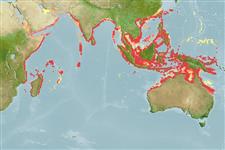>
Clupeiformes (Herrings) >
Engraulidae (Anchovies) > Engraulinae
Etymology: Stolephorus: Greek, stole, -es = garment + Greek, pherein = to carry (Ref. 45335).
Eponymy: Dr Philibert Commerson (1727–1773) was known as ‘doctor, botanist and naturalist of the King’. [...] (Ref. 128868), visit book page.
More on author: Lacepède.
Environment: milieu / climate zone / depth range / distribution range
Ökologie
seewasser; brackwasser; anadrom (Ref. 51243); tiefenbereich 0 - 50 m (Ref. 82332). Tropical (Ref. 123745)
Indian Ocean: endemic off Mauritius (Ref. 123745). Its distribution in eastern coast of Africa, from Gulf of Aden to Zanzibar, northern Madagascar, eastward to Hong Kong and Papua New Guinea (Ref. 189) is based on misidentifications for other species: Stolephorus mercurius (SE Asia), S. rex (Indo-West Pacific) and S. zephyrus (eastern coast of Africa to Madagascar) (Ref. 123745).
Length at first maturity / Size / Gewicht / Alter
Maturity: Lm 7.2 range ? - ? cm
Max length : 11.2 cm SL Männchen/unbestimmt; (Ref. 123745)
Afterflossenstacheln: 0; Afterflossenweichstrahlen: 21 - 22. Diagnosis: Body somewhat compressed, belly a little rounded, with 0-5 small needle-like pre-pelvic scutes; maxilla tip pointed, reaching to or a little beyond hind border of pre-operculum, the latter convex, rounded; lower gillrakers usually 23 to 28; small teeth present on upper edge of hyoid bones; isthmus muscle tapering evenly forward to hind border of branchial membrane; pelvic fin tips reaching to below anterior dorsal finrays; anal fin short, with usually 3 unbranched and 18-19 branched finrays, its origin below second half of dorsal fin base; body light transparent fleshy brown, with a silver stripe down flank; a pair of dark patches behind occiput, followed by a pair of dark lines to dorsal fin origin (Ref. 189). It closely resembles Stolephorus apiensis of Fiji and Samoa, which lacks pigment lines before the dorsal fin; and S. brachycephalus of Papua New Guinea, which has more anal finrays, no hyoid teeth, and more scutes; Stolephorus waitei has characteristic spots on the lower part of the head, and the pelvic fins do not reach to the dorsal fin origin, as also in S. chinensis; other Stolephorus species have the hind border of the pre-operculum concave near the maxilla tip (Ref. 189).
A schooling fish found in coastal waters, apparently entering brackish water (Ref. 189), at depths of 0-50 m (Ref. 82332). It feeds on surface plankton, primarily copepods and prawn larvae (Ref. 189). Eggs are oval with a knob (Ref. 189). Used for food and fish meal (Ref. 4537).
Hata, H., S. Lavoué and H. Motomura, 2021. Taxonomic status of nominal species of the anchovy genus Stolephorus previously regarded as synonyms of Stolephorus commersonnii Lacepède 1803 and Stolephorus indicus (van Hasselt 1823), and descriptions of three new species (Clupeiformes: Engraulidae). Ichthyol. Res. 68(3):327-372. (Ref. 123745)
IUCN Rote Liste Status (Ref. 130435: Version 2024-2)
Bedrohung für Menschen
Harmless
Nutzung durch Menschen
Fischereien: kommerziell
Tools
Zusatzinformationen
Download XML
Internet Quellen
Estimates based on models
Preferred temperature (Ref.
123201): 25 - 29.1, mean 28.3 °C (based on 1386 cells).
Phylogenetic diversity index (Ref.
82804): PD
50 = 0.5000 [Uniqueness, from 0.5 = low to 2.0 = high].
Bayesian length-weight: a=0.00513 (0.00383 - 0.00686), b=3.14 (3.10 - 3.18), in cm total length, based on LWR estimates for this species (Ref.
93245).
Trophic level (Ref.
69278): 3.1 ±0.20 se; based on food items.
Widerstandsfähigkeit (Ref.
120179): hoch, Verdopplung der Population dauert weniger als 15 Monate. (K=0.95-0.96).
Fishing Vulnerability (Ref.
59153): Low vulnerability (14 of 100).
Nutrients (Ref.
124155): Calcium = 449 [145, 1,234] mg/100g; Iron = 2.49 [1.36, 4.40] mg/100g; Protein = 19.1 [17.3, 21.0] %; Omega3 = 0.447 [0.194, 1.040] g/100g; Selenium = 46.6 [20.7, 99.9] μg/100g; VitaminA = 36.1 [7.7, 152.2] μg/100g; Zinc = 2.92 [1.90, 4.37] mg/100g (wet weight); based on
nutrient studies.
